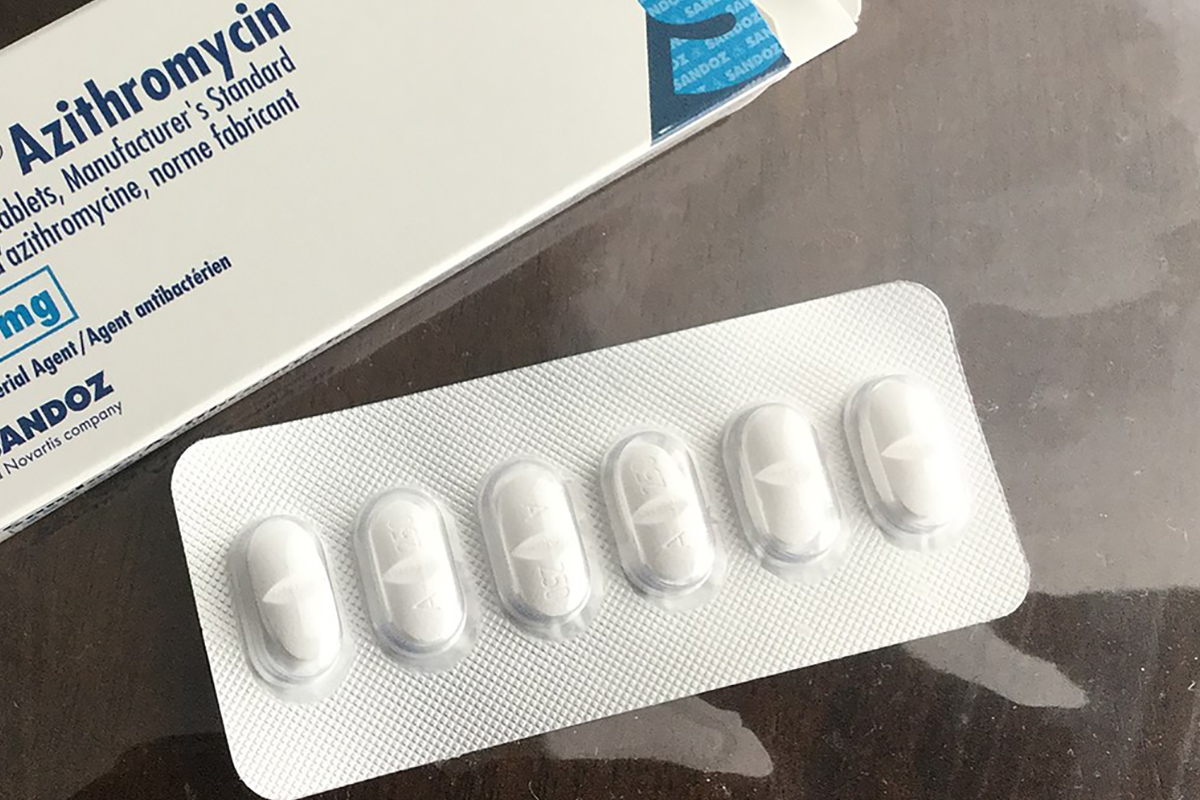Ventricular Arrhythmia Risk Due to Hydroxychloroquine-Azithromycin Treatment For COVID-19
KEY POINTS
- Safety considerations for inpatient and outpatient use of hydroxychloroquine and chloroquine in clinical practice are outlined below.
- Hydroxychloroquine or chloroquine therapy should occur in the context of a clinical trial or registry, until sufficient evidence is available for use in clinical practice.
- Hydroxychloroquine or chloroquine use outside of a clinical trial should occur at the direction of an infectious disease or COVID-19 expert, with cardiology input regarding QT monitoring.
- Additional sources of expert guidance with detailed and general arrhythmia monitoring considerations are also available.
- The intensity of QT and arrhythmia monitoring should be considered in the context of potential drug benefit, drug safety, resource availability and quarantine considerations.
- IRB-approved protocols should guide use of hydroxychloroquine or chloroquine for pandemic research; suggestions for researchers are outlined here.

In vitro and preliminary clinical research have suggested that hydroxychloroquine alone and in combination with azithromycin could prove to be an effective treatment for COVID-19.
A small study in France enrolling 26 treated patients and 16 non-randomized controls showed that hydroxychloroquine alone or in combination with azithromycin shortened the time to resolution of viral shedding of COVID-19.1
Based on this study, clinicians in many countries have begun using these medications in clinical practice, and multiple randomized trials are being initiated. However, chloroquine, hydroxychloroquine and azithromycin all prolong QT interval, raising concerns about the risk of arrhythmic death from individual or concurrent use of these medications.
Both the concerns regarding mortality risk, and the intensity of QT and arrhythmia monitoring should be considered in the context of several important mitigating factors:
- The duration of use for these medications for COVID-19 infection is short (5 to 10 days for acute illness).
- While QT-prolonging medication use has been associated with increased risk of death, this risk may be smaller than the potential benefit from treatment of COVID-19 for some patients.
- There are large potential population-health benefits from hastening viral clearance of COVID-19.
We strongly encourage enrollment of patients in clinical research protocols, whenever available. All clinical use that occurs outside of a research setting should incorporate anticipated benefits balanced against risks.
Currently, there is hope for benefit from hydroxychloroquine, yet there is little evidence. That is likely to rapidly change, given many pending clinical studies.
Arrhythmogenicity of Hydroxychloroquine and Azithromycin

Drug-induced QT prolongation has long served as a surrogate indicator for increased risk of drug-associated torsades de pointes (TdP), a potentially lethal polymorphic ventricular tachycardia. However, the relationship between QT prolongation and risk of TdP is imperfect and complex. The risk of TdP is not a linear function of QT duration nor the extent of change; some drugs which prolong QTc are not associated with increased arrhythmic death.2,3
Although only a small proportion of patients with QTc prolongation suffer TdP, drug-associated QT prolongation is associated with increased arrhythmic and non-arrhythmic mortality and it therefore continues to be an important metric of drug safety.4,5
Chloroquine, and its more contemporary derivative hydroxychloroquine, have remained in clinical use for more than a half-century as an effective therapy for treatment of some malarias, lupus, and rheumatoid arthritis. Data show inhibition of iKr and resultant mild QT prolongation associated with both agents.
Despite these suggestive findings, several hundred million courses of chloroquine have been used worldwide making it one of the most widely used drugs in history, without reports of arrhythmic death under World Health Organization surveillance.4
Nonetheless, the absence of an active drug safety surveillance system in most countries limits reassurance from these observations.

Azithromycin, a frequently used macrolide antibiotics lacks strong pharmacodynamic evidence of iKr inhibition. Epidemiologic studies have estimated an excess of 47 cardiovascular deaths which are presumed arrhythmic per 1 million completed courses, although recent studies suggest this may be overestimated.6-7
There is limited data evaluating the safety of combination therapy, however in vivo studies have shown no synergistic arrhythmic effects of azithromycin with or without chloroquine.8
A number of factors are known to contribute to increased risk of drug-induced TdP including female sex, structural heart disease, congenital long-QT syndromes, electrolyte disturbances, hepatic/renal failure and concomitant QT prolonging medications.6
The safety of QT prolonging medications may be maximized by close monitoring and optimization of these factors. A risk score has been derived and validated by Tisdale et al., for prediction of drug-associated QT prolongation among cardiac-care-unit-hospitalized patients (Table 1).9
Table 1. Risk Score For Drug-Associated QTc Prolongation9
| Risk Factors | Points |
| Age ≥68 y | 1 |
| Female sex | 1 |
| Loop diuretic | 1 |
| Serum K+ ≤3.5 mEq/L | 2 |
| Admission QTc ≥450 ms | 2 |
| Acute MI | 2 |
| ≥2 QTc-prolonging drugs | 3 |
| sepsis | 3 |
| Heart failure | 3 |
| One QTc-prolonging drug | 3 |
| Maximum Risk Score | 21 |
| K+ indicates potassium; and MI, myocardial infarction. | |
A Tisdale score of ≤ 6 predicts low risk, 7-10 medium risk, and ≥ 11 high risk of drug-associated QT prolongation (Table 2).
Table 2. Risk Levels For Drug-Associated QT Prolongation9
| Low risk = ≤6 points |
| Moderate risk = 7-10 points |
| High-risk = ≥11 points |
Suggested Monitoring For Inpatient Clinical Use
Table 3. QTc Formulas; Consider Using Fridericia or Framingham Correction, Especially for Heart Rates Over 90 BPM10
| Fridericia | QTc = QT / |
|
| Framingham | QTc = QT + 0.154(1-RR) | |
| Hodges | QTc = QT + 1.75(HR-60) | |
| Bazett | QTc = QT /
|
Patients admitted with COVID-19 are likely to have longer baseline QTc and have higher potential arrhythmic risks as a result of the metabolic and physiologic sequelae of their illness, and a typically greater burden of comorbid disease.
However, given the severity of illness, hospitalized and critically ill patients may also derive the most benefit from potentially effective therapies.
The goal of QTc screening in this setting is not to identify patients whom are not candidates for therapy, but to identify those who are at increased risk for TdP so aggressive countermeasures may be implemented.
If otherwise ready for discharge, patients who have had QT intervals that are well within normal range and have had no concerning arrhythmias on telemetry should not be held in the hospital exclusively for the purpose of hydroxychloroquine-related arrhythmia monitoring.
- Baseline
- Discontinue and avoid all other non-critical QT prolonging agents.
- Assess a baseline ECG, renal function, hepatic function, serum potassium and serum magnesium.
- When possible, have an experienced cardiologist/electrophysiologist measure QTc, and seek pharmacist input in the setting of acute renal or hepatic failure.
- Relative contraindications (subject to modification based on potential benefits of therapy)
- History of long QT syndrome, or
- Baseline QTc >500 msec (or >530-550 msec in patients with QRS greater than >120 msec)
- Ongoing monitoring, dose adjustment and drug discontinuation
- Place on telemetry prior to start of therapy.
- Monitor and optimize serum potassium daily.
- Acquire an ECG 2-3 hours after the second dose of hydroxychloroquine, and daily thereafter.
- If QTc increases by >60 msec or absolute QTc >500msec (or >530-550 msec if QRS >120 msec), discontinue azithromycin (if used) and/or reduce dose of hydroxychloroquine and repeat ECG daily.
- If QTc remains increased >60 msec and/or absolute QTc >500 msec (or >530-550 msec if QRS >120 msec), reevaluate the risk/benefit of ongoing therapy, consider consultation with an electrophysiologist, and consider discontinuation of hydroxychloroquine.
Suggested Monitoring For Outpatient Clinical Use

Patients who are stable for outpatient therapy may be less at risk for complications, but are unlikely to have access to close monitoring.
As for inpatients, QTc screening should be incorporated into an individualized risk-benefit consideration for treatment.
If outpatient ECG assessment is impossible or poses undue risk of infection for others, the necessity of treatment should be balanced against risk when considering alternative monitoring methods or omitting monitoring.
- Baseline
- Discontinue and avoid all other non-critical QT prolonging agents.
- Assess a baseline ECG, renal function, hepatic function, serum potassium and serum magnesium.
- When possible, have an experienced cardiologist/electrophysiologist measure QTc.
- Avoid outpatient initiation in the setting of acute renal or hepatic failure.
- Relative contraindications (subject to modification based on potential benefits of therapy)
- History of long QT syndrome, or
- Baseline QTc >480 msec (or >510-530 msec if QRS >120 msec), or
- Tisdale risk score ≥11
- Ongoing monitoring, dose adjustment and drug discontinuation
- If quarantine or resource constraints are prohibitive, consider no further ECG / telemetry assessment if Tisdale risk score ≤6. Also consider use of alternative mechanisms of QT and arrhythmia assessment outlined below.
- Otherwise, repeat ECG 2-3 hours after dosing on day 3 of therapy. If QTc increases by >30-60 msec or absolute QTc >500msec (or >530-550 msec if QRS >120 msec), consider discontinuing therapy.
Protocol Modifications in the Setting of Limited Resources or Quarantines
QT-prolonging medication initiation may be considered in the absence of ECG, telemetry or in-office assessment capability for patients with Tisdale risk score ≤6, in the setting of resource scarcity.
Additional considerations may include:
- Personal protective equipment (PPE) shortages: To minimize use of PPE, ECGs may be performed to coincide with "clustered" care between 2 and 4 hours after dosing. To further reduce exposure or save PPE resources, QTc monitoring may be performed using surrogates for 12-lead ECG assessment, including QTc monitoring via inpatient telemetry, direct-to-consumer mobile devices (e.g., KardiaMobile 6-lead, KardiaMobile 1-lead and Apple Watch 1-lead), or prescription mobile cardiac outpatient telemetry devices (e.g., iRhythm, BioTel and Preventice).
- Telemetry shortages: If telemetry resources are limited, their use must be triaged based on clinical importance. Local protocols should be created to weigh the arrhythmia risks across the spectrum of hospitalized patients. Patients already on therapy with QTc values in the clearly acceptable range could be considered for ongoing hydroxychloroquine use without telemetry. Patients initiating therapy with Tisdale risk score ≤6 can similarly be considered for use without monitoring. For higher risk patients who would otherwise not have access to inpatient telemetry, mobile cardiac outpatient telemetry could be considered for use in the hospital. In this telemetry-triage context, any syncope should be considered due to polymorphic VT and should prompt ECG and reinitiation of telemetry.
- Minimizing exposure/contact: It may be reasonable to forego ECG screening to allow patients to remain in quarantine if no high-risk features exist (history of long QT syndrome, concomitant QT prolonging medications, structural or ischemic heart disease, history of prolonged QTc on any ECG, history of abnormal renal function and/or electrolytes).
- Maximizing telephone assessment: All patients/ research subjects should have close monitoring of symptoms with attention to indicators of arrhythmia risk (syncope, dehydration, initiation of new medications and worsening of health status).
References
- Guatret et al. (2020) Hydroxychloroquine and azithromycin as a treatment of COVID-19: results of an open-label non-randomized clinical trial. Int J of Antimi Agents. DOI:10.1016/j.ijantimicag.2020.105949.
- Rock EP, Finkle J, Fingert HJ, et al. Assessing 13 proarrhythmic potential of drugs when optimal studies 14 are infeasible. Am Heart J. 2009;157(5):827-836.e1. 15 Medline:19376308 doi:10.1016/j.ahj.2009.02.020 16
- Hohnloser SH, Klingenheben T, Singh BN. Amiodarone-17 associated proarrhythmic effects: a review with special 18 reference to torsade de pointes tachycardia. Ann Intern Med. 1994;121(7):529-535. Medline:8067651 1 doi:10.7326/0003-4819-121-7-199410010-00009
- Chugh SS, Reinier K, Singh T, et al. Determinants of prolonged QT interval and their contribution to sudden death risk in coronary artery disease: The Oregon Sudden Unexpected Death Study. Circulation. 2009;119:663-670.
- Simpson T, Salazar J, Vittinghoff E, et al. Association of QT prolonging medications with risk of autopsy causes of sudden death. JAMA Int Med. 2020;180(5):1-9.
- "The Cardiotoxicity of Antimalarials." World Health Organization- Malaria Policy Advisory Committee Meeting. 22 Mar, 2017. Available here.
- Ray W, Murray K, Hall K, Arbogast P, Stein M. Azithromycin and the risk of cardiovascular death. New Engl J Med. 2012;366:1881-1890.
- Fossa A, Wisialowski T, Duncan J, et al. Azithromycin/chloroquine combination does not increase cardiac instability despite an increase in monophasic action potential duration in the anesthetized guinea pig. Am J Trop Med Hyg. 2007;77(5): 929-38.
- Tisdale JE, Jayes HA, Kingery JR, et al. Development and validation of a risk score to predict QT interval prolongation in hospitalized patients. Circ Cardiovasc Qual Outcomes. 2013;6:479-487.
- Vanderberk B, Vandael E, Robyns T, et al. Which QT correction to use for QT monitoring?. J Am Heart Assoc. 20163;5:e003264.
Clinical Topics: Arrhythmias and Clinical EP, Congenital Heart Disease and Pediatric Cardiology, COVID-19 Hub, Implantable Devices, Genetic Arrhythmic Conditions, SCD/Ventricular Arrhythmias, Atrial Fibrillation/Supraventricular Arrhythmias, Congenital Heart Disease, CHD and Pediatrics and Arrhythmias, CHD and Pediatrics and Quality Improvement, Novel Agents, Statins
Keywords: Cardiology Magazine, ACC Publications, Coronavirus, Acute Disease, Anti-Bacterial Agents, Arrhythmias, Cardiac, Azithromycin, Chloroquine, Clinical Protocols, Communicable Diseases, COVID-19, Dehydration, Electrocardiography, Ethics Committees, Research, Hydroxychloroquine, Inpatients, Long QT Syndrome, Magnesium, Malaria, Outpatients, Quarantine, Registries, Potassium, Severe Acute Respiratory Syndrome, Sodium Chloride Symporter Inhibitors, Torsades de Pointes, Virus Shedding
< Back to Listings
